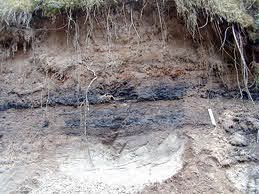Dy
Type of soil formed in nutrient low waters which mainly consist of very fine sunken organic components. Dy contains 50% carbon content. Dy is made when organic matter accumulates at the sediment-water interface from suspension or when its specific weight exceeds that of water. Degradation of the organic matter occurs under anaerobic conditions. Dy-layers are brown to black humus layers deposited in acidic waters that are poor in nutrients and have high concentrations of soluble organic compounds. Such deposits can be found in floodplains, fans, and deltas of rivers and streams.
Classification
Dy by definition lies in between dopplerite and gytjja and often exist within a gyttja-layer. Dopplerite are the humus colloids which are produced when dead plant material is destructed. Dy is a gyttja mixed with unsaturated humus colloids which are brought into the lake by streams draining nearly peat-bogs. In some research dy is called tyrfopel where it indicates a fine grained peat. However this term is not completely correct and can be used for the bottom deposits where peat detritus has spread over a quaking bog.
Characteristics
Dy is soft and hydrous and has a brown to brownish color right after excavation. When dy is dried up it is very hard and a slightly felty substance with dark brownish to black color. Its sediments are found in small lakes where Sphagnum mosses produce an acidic environment and contain some humic matter.
